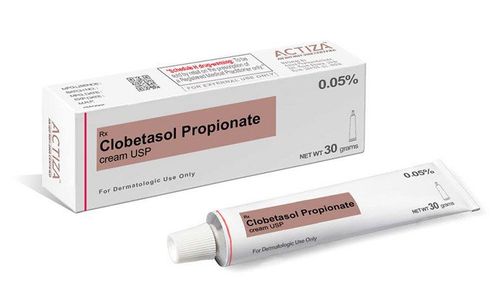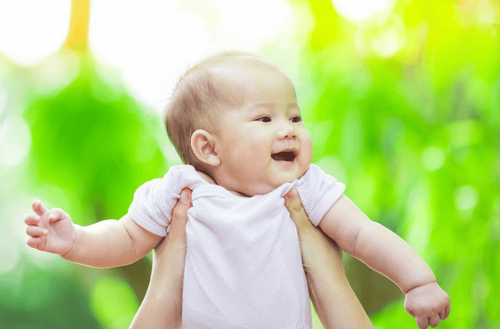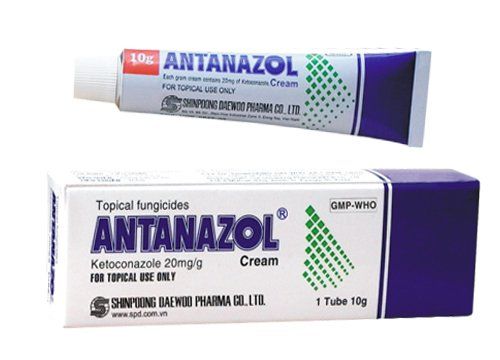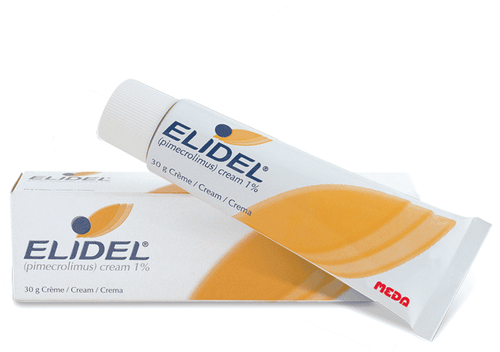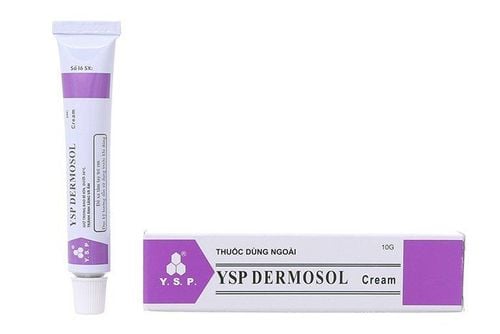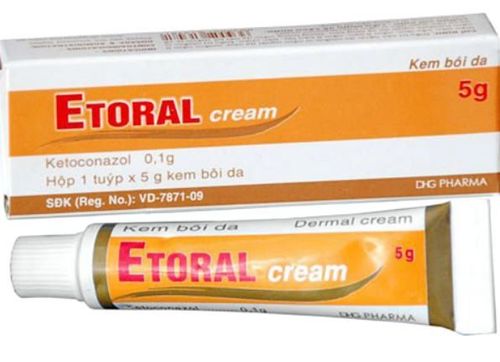This is an automatically translated article.
The article is professionally consulted by Master, Resident Doctor Dang Thi Ngoan - Pediatrician - Neonatologist - Department of Pediatrics - Neonatology - Vinmec Ha Long International Hospital.Rash, jaundice, eczema, ... are common skin diseases in babies. Although most skin diseases in babies are not life-threatening, parents still need to be vigilant and handle them promptly to avoid affecting the health and aesthetics of their children.
1. Jaundice This is a common skin disease in babies, the baby's skin and eyes will turn yellow. This condition is caused by excess bilirubin in the blood - a yellow pigment in red blood cells. Jaundice usually occurs when a newborn's liver is not mature enough to filter out bilirubin. As a result, premature babies and some breastfed babies are more susceptible to jaundice.
There are 2 levels of jaundice:
Physiological Jaundice: Appears 1 day after birth, the degree of yellowing is mild, concentrating only on the face, neck, chest and abdomen (above the navel); Pathological Jaundice: Dark yellow level, whole body and eyes, does not go away on its own after 1-2 weeks. Combined with unusual manifestations such as lethargy, lethargy, convulsions,... Jaundice can be treated with light therapy and regular breastfeeding to remove bilirubin from the blood.
Trắc nghiệm: Sự phát triển tinh thần, vận động của bé thế nào là đúng chuẩn?
Khi nào bé biết nói, biết hóng chuyện hay biết cầm cốc là "đúng chuẩn"? Điểm xem bạn biết được bao nhiêu mốc phát triển tinh thần, vận động "đúng chuẩn" của bé nhé!The following content is prepared under supervision of Thạc sĩ, Bác sĩ y khoa, Ma Văn Thấm , Nhi , Phòng khám Đa khoa Quốc tế Vinmec Dương Đông(Phú Quốc)
2. Rash
Is a skin inflammation when sweat glands are blocked, sweat cannot escape. The heat rash is small, pink, slightly hard, often floating on sweaty skin areas such as forehead, back, neck, chest. The cause may be due to scratches on the skin, hot summer weather or in winter when the child has a fever, wearing tight clothes.
The heat rash will go away when the child's body is clean and cool. But if the baby scratches and breaks the pimples, it can spread heat rash and cause superinfection. The way to prevent and treat heat rash for this newborn is:
Give your baby clothes that are thin, light, loose, and absorb sweat; Avoid rough, hard fabrics, which can irritate baby's skin; Bathe your baby with cool water every day; Should let the baby sit freely, lie down and play in a cool room on a hot day, avoid constant cuddling; Take the child to the doctor to treat the infection if it is severe (the baby is fussy, has a fever). 3. Milk acne, millet cyst Up to 20 - 40% of babies have milk acne, also known as millet cyst (in English, milia). This is a form of infant acne, formed due to the action of hormones received from the mother, or the baby has an enlarged sebaceous gland. The phenomenon of milk acne is quite common, can be seen immediately or a few weeks after giving birth. Acne usually appears on the cheeks, sometimes on the forehead, chin and back.
Milk acne in babies has the form of tiny, white nodules, surrounded by red skin. Your baby will develop more pimples or redness as his body temperature rises, or irritation from contact with saliva, breast milk, and detergents.
Usually, millet cysts in babies disappear within a few weeks or months. If acne persists for more than 3 months, you should take your baby to see a dermatologist. Note during the time the baby has milk acne:
Should not apply cream or medicine, as well as touch or rub on the acne spots; Bathe your baby daily with clean, cooled water and a gentle baby bath. Dry the body gently with a bucket towel after bathing; Baby blankets, cushions and clothes must be made of materials that are dry, friendly to children's skin and do not cause irritation; Do not let the room temperature get too hot, or wear a lot of clothes, wrap the child; Breastfeeding mothers should limit their intake of allergenic foods such as eggs, soy, peanuts, seafood, spicy and hot dishes.

4. Eczema (eczema) Eczema is one of the common skin diseases in babies, which is manifested by dry and red skin, gradually becoming rough and itchy, peeling skin. Eczema spots often appear on the face, elbows and feet of newborn babies.
The cause of the disease may be:
Baby's skin is dry and weak; Exposure to allergens such as: pet dander, dust, fabrics, cigarette smoke, perfumes, detergents... Bacteria. To treat Eczema, mothers need to bathe and clean the baby every day, but do not use soaps that irritate the skin. Pat dry after bathing to make sure your baby's skin is clean and dry. Daily apply moisturizing cream, soften the skin all over the baby's body, combined with anti-inflammatory drugs at the eczema.
5. Seborrheic Dermatitis Seborrheic dermatitis is also on the list of common skin diseases in infants aged 0 - 3 months, accounting for about 10% of cases. The disease is not contagious, nor is it due to poor care and hygiene by the mother. Usually, the disease will go away on its own after a short time, but some cases of seborrheic dermatitis can last until the child is 1 - 4 years old.
The disease usually appears on the scalp and oily areas such as behind the ears, under the eyebrows, or in the nose, armpits, groin. The oily flakes are yellow or white, flakes like dandruff, dry or greasy, but do not cause itching or discomfort. Folks often call this "buffalo shit".

Seborrheic dermatitis in babies can be caused by Malassezia fungus or hormones that increase sebum secretion in hair follicles. In children with seborrheic dermatitis, frequent washing of the hair with baby shampoo is required. You should use your hands to gently rub the scalp or use a soft brush to brush the scalp to gradually peel off the scales. Do not rub vigorously or use adult anti-dandruff shampoo to avoid damaging your baby's skin.
6. Some other common skin diseases in babies Hives Manifestations are skin rashes like mosquito bites, causing itching. Infants can develop this condition very early on due to an allergy to the protein in milk. Parents need to take their baby to see a pediatrician for the best treatment.
Scratches Newborn skin is very delicate, so it is easily scratched by friction with clothes or skin rubbing against each other. Therefore, the mother should not let the baby wear clothes that are too tight. If the scratch is large, you can apply a baby healing cream after consulting a doctor.
Rash, rash If you find some small, pink spots all over the body, it is likely that your baby has a rash. Extremely hot and humid temperatures can be the cause of this common skin disease in babies. To limit rashes, rashes, you should choose cool clothes for your baby, play in a cool place.
Red Scaly Acne Red, itchy, dry, oozing or scaly spots are indicative of atopic dermatitis. This skin disease in babies is caused by the baby's weak immune system, or the history of the parents. Children must be kept clean and treated as prescribed by a doctor to avoid aggravation.
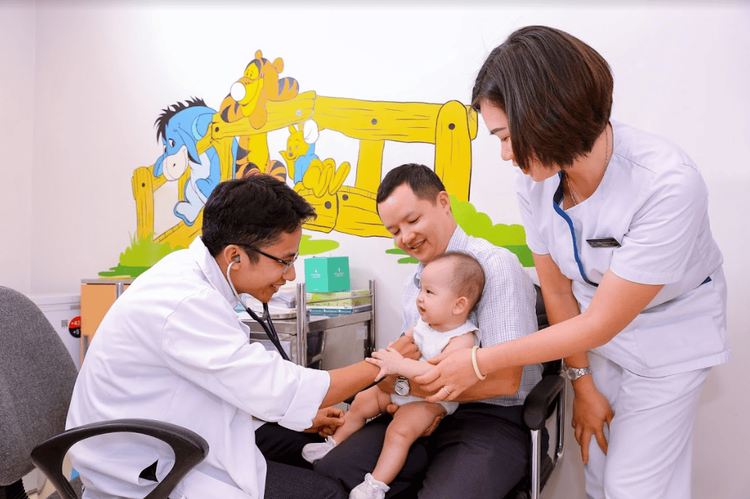
Newborn skin is very fragile, immature, prone to infections and scratches, so when babies have skin diseases, it is very likely to leave dangerous complications. Therefore, parents need to have knowledge about common skin diseases in babies to best protect their children. Accordingly, parents should let the baby wear cotton or silk clothes, play in a cool place and bathe daily with mild soap. Some skin diseases in babies usually go away on their own after a while with good care. In addition, parents should not arbitrarily use creams or gels for newborns, in case the child has severe symptoms, it is necessary to see a doctor soon.
Not only has strengths in examining and diagnosing diseases at an early stage, Vinmec also has strengths in intensive treatment and surgery for many difficult pediatric cases, providing prognosis for treatment and quick recovery. . In addition, in order to improve service quality, Vinmec International Hospital now also deploys a package of examination and consultation for treatment of atopic dermatitis to help customers assess the overall condition of the disease. advice on measures to help prevent recurrence of the disease.
When registering for a package of examination and consultation for treatment of atopic dermatitis, customers will receive: Dermatology specialist examination. Perform tests such as: quantitative IgE, fresh mycobacteria, specific IgE quantification with respiratory allergens - food (Panel 1 Viet), test Rida Allergy Screen (panel 1)... For young children, the doctor will directly examine and assign some suitable tests to diagnose the most accurate results. Therefore, parents can completely trust the methodical examination, diagnosis and treatment process at Vinmec.
To be examined and treated with leading Dermatologists in Vinmec, you can contact the Vinmec website for service.
Please dial HOTLINE for more information or register for an appointment HERE. Download MyVinmec app to make appointments faster and to manage your bookings easily.






